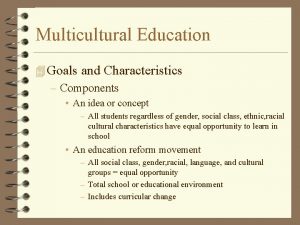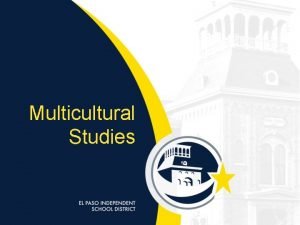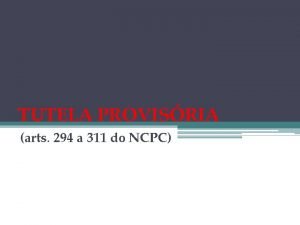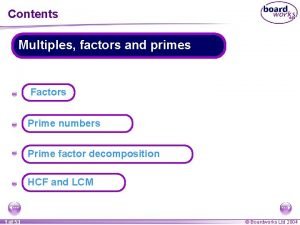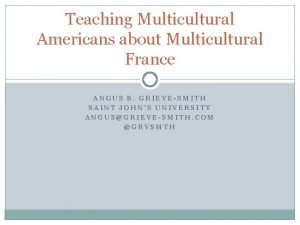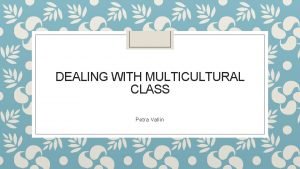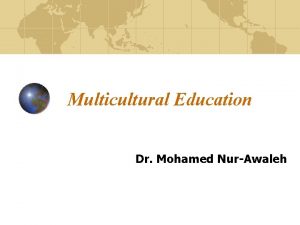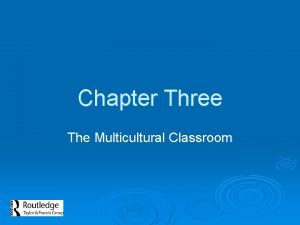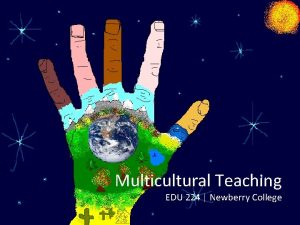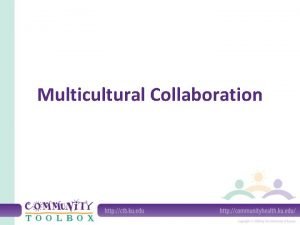Multicultural Goals Characteristics ED 294 Introduction to Multicultural











- Slides: 11

Multicultural Goals & Characteristics ED 294 Introduction to Multicultural Education

Historical Development of Multicultural Education 1. Grew out of 1960’s civil rights movement: African Americans then other groups demanded educational institutes reform curricula to reflect their own history, culture an perspectives. 2. Ethnic groups pushed for community control of schools and for the revision of textbooks

HISTORICAL DEVELOPMENT Success of the civil rights movement stimulated other marginalized groups to take action. The women’s right movement emerged as one of the most significant social reform movements. Feminists pushed for the revision of textbooks to include more history about the important roles of women.

Meaning of Culture Consists of shared beliefs, symbols, and interpretations within a human group. The intangible aspects of human societies. Not the tangible, artifacts and tools, but how members of the group interpret, use and perceive them. People in a culture usually interpret the meaning of symbols, artifacts, and behaviors in a similar way.

The Nature of Culture in the United States Macroculture: shared core culture • Equality: “all men are created equal, that they are endowed by their Creator with certain unalienable rights, that among these are life, liberty, and the pursuit of happiness. ” • Individualism & Individual Opportunity: “rags to riches”, “pull yourself up by your bootstraps” • Expansionism: desire to conquer & exploit the natural environment-the nations “inherent superiority”

Nature of Culture in the United States Microculture: Unique institutions, values, and cultural elements shared primarily by a specific cultural group. • Microcultures may have values that are alien to the national core macroculture. • Some microcultures are more group oriented vs. individualistic

Multiple Group Memberships 1. 2. 3. 4. 5. 6. Nationality Race/Ethnicity Religion Exceptionality Social Class Gender

Multiple Group Memberships “The more we know about a student’s level of identification with a particular group and the extent in which socialization has taken place with that group, the more we can predict, and understand the student’s behavior. ”

Social Categories (usually related to physical characteristics) • Gender: social class gender role expectations vary across cultures and • Sexual Orientation: equality Recognition is important for social • Race: Characteristics of a particular race vary across cultures ie; “money lightens”. • Social Class: Variables in income, education, occupation, life-style indicates social class status. • Exceptionality: Whether a person is considered disabled or gifted is determined by criteria developed by society

Dimensions of Multicultural Education • Content Integration: using examples from a variety of cultures and groups into subject areas • Knowledge of how we Construct Knowledge: the extent to which teachers help students understand determine how perspectives and biases influence how we construct knowledge. • Prejudice Reduction: lessons and activities teachers use to help students develop positive attitudes towards different racial, ethnic, and cultural groups • Equity Pedagogy: How teachers modify their teach to facilitate the academic achievement of students from diverse racial, cultural, gender, and social class groups • Empowering School Culture: Restructuring grouping & labeling. Interaction of staff and students across racial lines.

Reforming School Social Systems • • • Policy and Politics Culture and Hidden Curriculum Learning Styles of the School Languages and Dialects Community participation & Input Counseling Assessment and Testing Instructional Materials Teaching Styles School Staff: attitudes, perceptions, beliefs, and actions
 Characteristic of multicultural education
Characteristic of multicultural education Strategic goals tactical goals operational goals
Strategic goals tactical goals operational goals Strategic goals tactical goals operational goals
Strategic goals tactical goals operational goals Goals of multicultural education
Goals of multicultural education Art 294 a 311 novo cpc
Art 294 a 311 novo cpc Cmpe 294 sjsu
Cmpe 294 sjsu Aaa-294
Aaa-294 Factors of 294
Factors of 294 Pages 294 and 295
Pages 294 and 295 Bilangan biner dari 50
Bilangan biner dari 50 In 1971 there were 294 105 females
In 1971 there were 294 105 females Pengertian kubus
Pengertian kubus
